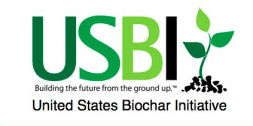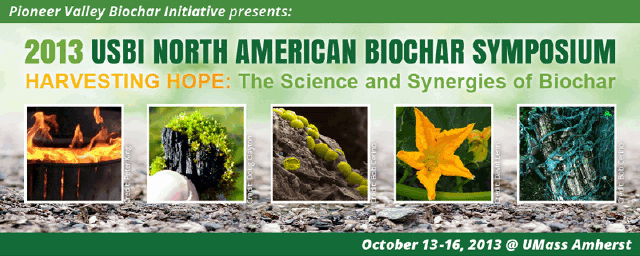Benefits & Uses of Biochar
Biochar & Soil Health
Wade Elmer presentation
B&U Session 5 - Silberg.pdf (1423 kB)
Joff Silberg presentation
B&U Session 4 - Holm.pdf (448 kB)
Tom Holm presentation
Location
CC 101
Start Date
15-10-2013 1:30 PM
End Date
15-10-2013 2:50 PM
Session Description
Disease Suppression: Earthworms, root health & biochar - Dr. Wade Elmer, CT Ag Experimental Station
Biochar, as a soil amendment, has shown much promise in increasing soil health by increasing soil fertility, reducing the damaging effect of allelopathy, suppressing root disease, and protecting plants from foliar pathogens. In greenhouse trials, we demonstrated that some biochar-amended soils could suppress root damage from soil borne fungi, while other biochars were less effective. One property associated with disease suppressing biochar might be its ability to alter the microbial communities like arbuscular mycorrhizae and florescent pseudomonads in the rhizosphere. A prerequisite for root health would be that roots be in contact with biochar. Manipulating root health in established plantings becomes problematic where susceptible roots are not easily available for manipulation. The use of earthworms as vehicles for delivery of biochar to lower soil horizon where susceptible root exist may circumvent the problem. We report on how earthworms and biochar might work in concert to enhance soil health.
Soil pathogen suppression using Biochar - Rice University
Biochars have been observed to trigger a range of changes in soil microbial processes, including altering microbial pathogen behavior and changing the behavior of bacteria central to soil nitrogen cycling, like Rhizobia species. A number of the bacteria influenced by biochar secrete and detect nonpolar organic compounds into their environment to monitor their populations and to communicate with plant symbionts. For example, pathogenic soil bacteria like E. carotovora use the concentration of cell-cell signaling compounds to determine if their population is large enough to successfully attack plant roots. Similarly, Rhizobia species use multiple cell-cell signaling compounds to manage aspects of N fixation. Biochar has been hypothesized to sorb the nonpolar compounds used by microbes to communicate, suppressing pathogenicity and accelerating soil N fixation. However, it is challenging to detect the binding of biochemical signals in the soil environment at rates relevant to microbial growth. Here we report the ability of biochar to interfere with microbial cell-cell communication on the timescale of bacterial reproduction. We show that this interference is a function of biochar production temperatures, with higher temperature chars more effectively sorbing cell-cell signaling compounds. Our results can be used to plan the use of biochars in soil pathogen suppression, and help explain one aspect of biochar-driven changes in soil N cycling.
PAHs in Corn Stover Biochar: Total Concentrations, Sorption, Bioavailability, and Effects of Aging: Tom Holm
Certain biochars contain polycyclic aromatic hydrocarbons (PAHs) which are carcinogenic. The amount of PAH content varies by feedstock, pyrolysis temperature and pyrolysis atmosphere. This presentation will discuss results from a study that looked at biochar produced by slow pyrolysis of corn stover in a nitrogen atmosphere at 450°, 550°, and 750°C.
Experiments using pyrene as a probe compound were performed. The experiments included sorption and mild extraction with 2-hydroxypropyl-b-cyclodextrin (HPCD), which mimics bioavailability. The sorption data were well described by Freundlich isotherms. Pyrene sorption was strong for all chars, with the amount sorbed at 1 mg L-1 dissolved pyrene ranging from 106 to over 107 mg kg-1. The pyrene content of the chars was too low to detect any pyrene in the HPCD extracts, so the chars were equilibrated with pyrene before extraction. Only 10-15% of added pyrene was HPCD-extractable from the 450° char and 1 – 5% from the 550° and 750° chars. The chars were subjected to artificial aging, i.e., incubation of moist char at -15°, 60°, and 110°C. Aging had small but measureable effects on both sorption and HPCD extraction of pyrene.
Biochar & Soil Health
CC 101
Disease Suppression: Earthworms, root health & biochar - Dr. Wade Elmer, CT Ag Experimental Station
Biochar, as a soil amendment, has shown much promise in increasing soil health by increasing soil fertility, reducing the damaging effect of allelopathy, suppressing root disease, and protecting plants from foliar pathogens. In greenhouse trials, we demonstrated that some biochar-amended soils could suppress root damage from soil borne fungi, while other biochars were less effective. One property associated with disease suppressing biochar might be its ability to alter the microbial communities like arbuscular mycorrhizae and florescent pseudomonads in the rhizosphere. A prerequisite for root health would be that roots be in contact with biochar. Manipulating root health in established plantings becomes problematic where susceptible roots are not easily available for manipulation. The use of earthworms as vehicles for delivery of biochar to lower soil horizon where susceptible root exist may circumvent the problem. We report on how earthworms and biochar might work in concert to enhance soil health.
Soil pathogen suppression using Biochar - Rice University
Biochars have been observed to trigger a range of changes in soil microbial processes, including altering microbial pathogen behavior and changing the behavior of bacteria central to soil nitrogen cycling, like Rhizobia species. A number of the bacteria influenced by biochar secrete and detect nonpolar organic compounds into their environment to monitor their populations and to communicate with plant symbionts. For example, pathogenic soil bacteria like E. carotovora use the concentration of cell-cell signaling compounds to determine if their population is large enough to successfully attack plant roots. Similarly, Rhizobia species use multiple cell-cell signaling compounds to manage aspects of N fixation. Biochar has been hypothesized to sorb the nonpolar compounds used by microbes to communicate, suppressing pathogenicity and accelerating soil N fixation. However, it is challenging to detect the binding of biochemical signals in the soil environment at rates relevant to microbial growth. Here we report the ability of biochar to interfere with microbial cell-cell communication on the timescale of bacterial reproduction. We show that this interference is a function of biochar production temperatures, with higher temperature chars more effectively sorbing cell-cell signaling compounds. Our results can be used to plan the use of biochars in soil pathogen suppression, and help explain one aspect of biochar-driven changes in soil N cycling.
PAHs in Corn Stover Biochar: Total Concentrations, Sorption, Bioavailability, and Effects of Aging: Tom Holm
Certain biochars contain polycyclic aromatic hydrocarbons (PAHs) which are carcinogenic. The amount of PAH content varies by feedstock, pyrolysis temperature and pyrolysis atmosphere. This presentation will discuss results from a study that looked at biochar produced by slow pyrolysis of corn stover in a nitrogen atmosphere at 450°, 550°, and 750°C.
Experiments using pyrene as a probe compound were performed. The experiments included sorption and mild extraction with 2-hydroxypropyl-b-cyclodextrin (HPCD), which mimics bioavailability. The sorption data were well described by Freundlich isotherms. Pyrene sorption was strong for all chars, with the amount sorbed at 1 mg L-1 dissolved pyrene ranging from 106 to over 107 mg kg-1. The pyrene content of the chars was too low to detect any pyrene in the HPCD extracts, so the chars were equilibrated with pyrene before extraction. Only 10-15% of added pyrene was HPCD-extractable from the 450° char and 1 – 5% from the 550° and 750° chars. The chars were subjected to artificial aging, i.e., incubation of moist char at -15°, 60°, and 110°C. Aging had small but measureable effects on both sorption and HPCD extraction of pyrene.



Bio and Photo
Wade Elmer
Joff Silberg
Tom Holm is a groundwater geochemist at the Illinois State Water Survey. Besides biochar and organic contaminants, his research interests include trace metal and arsenic geochemistry and sediment geochemistry. He got his B. S. in chemistry from Portland State University and his Ph.D. in Environmental Engineering Science from the California Institute of Technology. Before joining the Water Survey he was a postdoctoral research associate in the Water Chemistry Program at the University of Wisconsin, Madison and a Research Assistant Professor in the Department of Civil and Mineral Engineering at the University of Minnesota, Twin Cities.